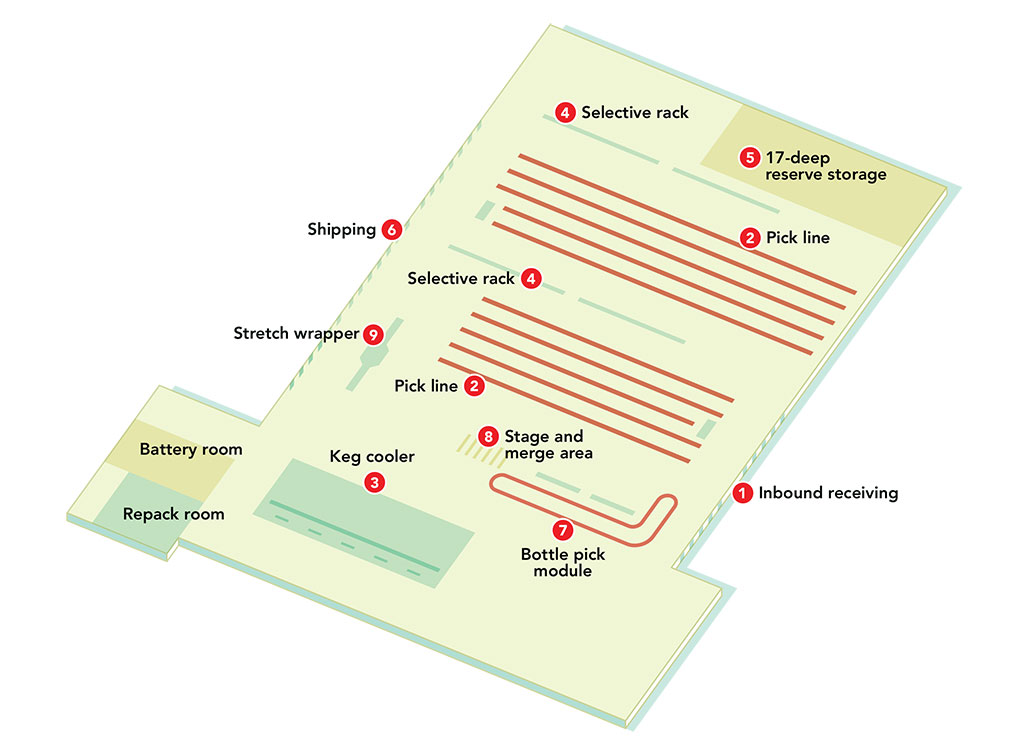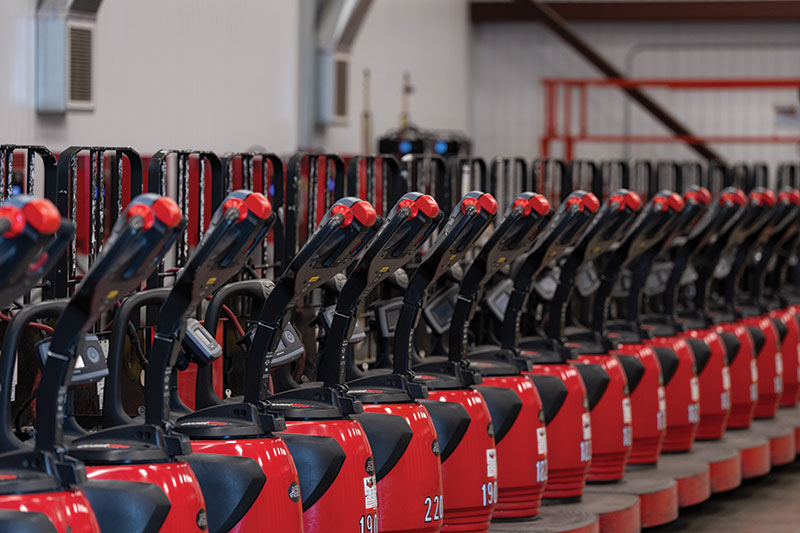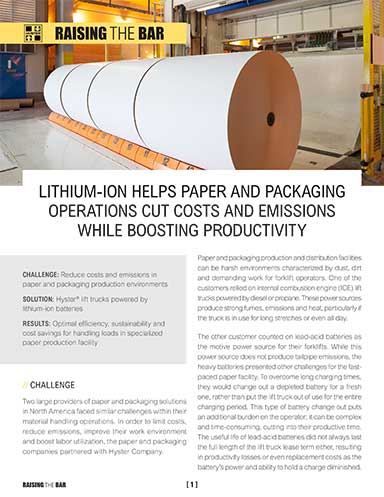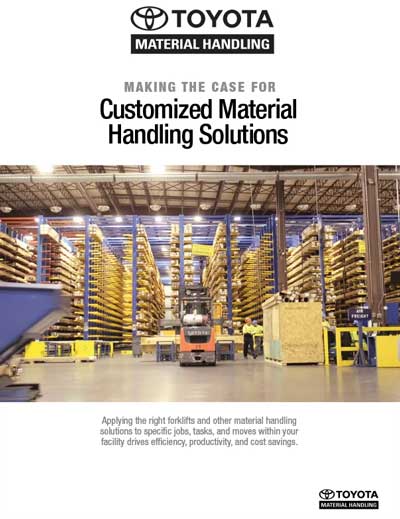The Odom Corporation: A lift truck for every process
In Anchorage, The Odom Corporation relies on lift trucks, fleet management software and lift truck add-ons to manage its beverage distribution center.
To say that The Odom Corporation makes the most of its fleet of 64 lift trucks (Raymond Corporation), with seven more on order, is an understatement.
A leading distributor of beverages in Alaska, Hawaii, Washington and Idaho, Odom not only operates a diverse fleet of lift trucks, it has also improved its operations with complimentary technologies that optimize the fleet and operators, including fleet management software, a labor management system associated with the lift truck software, voice and light-directed picking to optimize pick-to-pallet operations and radio-controlled shuttles that put pallets away into deep rack storage.
Despite all of that, as recently as 2000, operations were very labor intensive, with forklifts seeing limited duty in some facilities, according to Mike McCartney, director of operations for Alaska and Hawaii. Fast forward to 2023, “and everything we do is tied into our forklift fleet,” says McCartney. “They’re not just forklifts anymore. They’re computers that we’ve tied into facility safety and employee goals.”
The Odom Corporation has a long, rich history of territory expansion and is a preferred consolidator for many of its supplier partners. McCartney credits the transition to lift truck-centered operations that support the company’s growth across new geographies and its ability to cope with the growing number of SKUs. “Lift trucks have allowed us to bring in more brands and more SKUs,” McCartney says. “If the lift trucks don’t run, we stop.”
A decade-long relationship with Odom’s lift truck supplier has also been a contributing factor to the company’s adoption of technologies like fleet management and pick-to-light, along with technical support, maintenance services and parts.
“They have offered us more than just a forklift,” McCartney says.
Distribution success
Beverage distribution is usually dictated by the type of beverage being sold; the rights to distribute certain brands; and protected sales territories. “Every state has unique geographic challenges, but we have developed the ability to operate in two of the most unique, Alaska and Hawaii, where a significant volume of our shipments are by ocean freight,” says McCartney.
The company was founded by Milt Odom in Juneau, Alaska, in 1933 to sell bourbon, liquor, coffee, tea, spices, meats, candy and other dry goods. Four years later, Odom acquired the franchise rights to Coca-Cola for $1. By the 1970s, The Odom Corporation had moved its corporate headquarters from Alaska to Seattle and expanded into the Pacific Northwest, including parts of Idaho and Washington. It had also acquired the distribution rights to the Miller Brewing Co., Dr. Pepper, 7-Up, Hires Root Beer and Crush. Recent years have seen further expansion into Hawaii and Western Washington plus the addition of wine and spirits distribution. Today, the company employs more than 2,000 team members.
As McCartney recalls, his lift truck journey began around 2001, the year that Odom bought Empire Beverage, a small family-owned distributor in Spokane. McCartney had been working at Empire for about a year, picking orders to a push cart on the night shift.
Following its acquisition, the Spokane facility was overwhelmed by new brands, more SKUs and more order volume than it had ever dealt with in the past. “We only had one old lift truck that we drove about three minutes a day,” McCartney says. Otherwise, cases were picked to carts.
One warehouse associate, who had experience with pallet jacks and lift trucks, took it upon himself to call a local Toyota distributor. About three days later, the first pallet jack showed up. “Overnight, our whole operations changed because we now had the right equipment to do the job,” McCartney says.
In 2018, McCartney moved to Odom’s Anchorage, Alaska, location; and, after establishing a relationship with Raymond, began to expand the lift truck fleet, the number of lift truck types in use and to add complimentary technologies that made Odom associates more productive. “I went from not knowing what a forklift was to not understanding how anyone can live without one,” McCartney says.
Geography dictates distribution
Although Odom operates in four states, including Hawaii, Washington and Idaho, this article focuses on the Alaska operations. The company is responsible for distributing Coca-Cola products across much of the state, plus beer, wine and spirits. Wine and spirits are distributed through a partnership with Southern Glazer’s Wine & Spirits.
“If you want to do business in Alaska, you’re going to talk to Odom because we represent the brands consumers are looking for.” McCartney notes. The same is true of customers that want to order soft drinks, beer or wine and spirits.
The company manages five primary distribution centers in Anchorage, Kenai, Juneau, Fairbanks and Kodiak, an island south of Anchorage. The latter receives multiple containers per week based on seasonality. Smaller satellite facilities receive deliveries from the primary DCs and crossdock the product into trucks for customer deliveries.
The operating model is like most beverage distributors, where orders received before today’s cutoff time are delivered tomorrow—but with a twist. That’s because the sheer size of the state is intimidating; if you laid a map of Alaska over the United States, Juneau, the state capital, would be in Florida and the Aleutian Islands would be in California.
What’s more, only 20% of the state’s 590,000 square miles are accessible by road, so many locales can only be reached by boat or plane. Juneau, for instance, is the only U.S. state capital you can’t drive to. Product for that DC is shipped by barge from the port in Tacoma, Wash. Cases for Barrow travel by plane. In the winter, that plane may be met by a dog sled.
“If you can strap a case of beverage to it, we have probably used it for delivery,” McCartney says. “We’ll find a way to service you no matter where you’re located.”
The Anchorage facility maintains 10,500 active SKUs; factor in seasonal products and the database manages more than 30,000 SKUs.
The workhorse for all that product is the fleet of 36 pallet jacks; however, Odom is also using 11 sitdown forklifts, 16 reach trucks and one man-up orderpicker in the facility.
Expanding capabilities
In 2017 and 2018, the Odom team began to add lift truck-related technologies to its fleet to drive productivity without the addition of automation, other than the pick module conveyor system. The starting point was the implementation of Raymond’s iWarehouse fleet management system in Anchorage, which has since been rolled out in other facilities in the network.
Odom Corporation’s Lift Truck Fleet
| Forklift type | In use | On order | Grand Total |
| Forklift | 11 | 1 | 12 |
| Pallet jack | 36 | 4 | 40 |
| Reach truck | 16 | 2 | 18 |
| Orderpicker | 1 | 0 | 1 |
| Total: | 64 | 7 | 71 |
The initial application was impact monitoring to mitigate damage to racks, which could lead to rack failure. “We were having damage problems,” McCartney recalls, “but without technology, there was no way to know who was responsible for running into the racks.” Telematics capture the time when any impact occurs and the operator involved in the impact; the system then forwards that information to a supervisor. “That allows us to train and coach our operators,” McCartney says. “We saw improvements almost immediately.”
The next step was to use the system to replace paper-based pre-trip inspections with an electronic checklist for OSHA compliance. That gave Odom physical control over the trucks, as a lift truck won’t run until an operator has completed the checklist; if that operator gets off the truck for any reason, no one else can operate the equipment without starting the inspection process all over again. That ensures that no one who isn’t certified can use the equipment and drive off.
Odom is now using the system to analyze how, and how often, a given piece of equipment is being used. “The fleet management system shines a light on how we’re operating the lift trucks and gives us feedback that’s actionable,” McCartney says. “If we’re not lifting and only using a truck for transportation, we can replace that with a golf cart or a pair of shoes.”
A second add-on technology was a labor management system that captures scans and lift truck travel to analyze employee efficiency and productivity. “Most companies rate their employees on a metric like how many cases they pick in an hour,” McCartney says. “But one associate might have to drive to 37 locations to pick 50 cases, where another may get 50 picks at one location.”
By mapping the warehouse, an algorithm in the labor management system can take travel time into consideration when it is analyzing worker productivity. “We can now give an employee travel credit,” McCartney says. “That’s an important tool for tracking employee metrics and potentially how employees are compensated.”
A third tool was a combination of voice- and put-to-light technology to direct picking cases to pallets. In a typical process, an operator picks orders for up to 15 customers at a time across three pallets on a pallet jack. Voice technology tells the operator which cases and in what quantities to pick; LED lights embedded on the pallet jack indicate on which pallet to place the cases.
“Putting a case to the wrong pallet used to be our No. 1 problem,” says McCartney. “Now, our operators can be very accurate in a dynamic and challenging picking environment.”
The last add-on is a radio-controlled pallet shuttle to putaway and retrieve pallets from 17-deep pallet rack. “This allowed us to transition from floor storage to very dense storage without having to allocate valuable storage space to aisles for the forklifts to enter the racks,” McCartney says. He estimates that the shuttles increased pallet density by 50% over traditional drive-through rack.
While lift trucks and lift truck technologies have led to productivity improvements, McCartney says the most important value has come from Odom’s long-term partnership with its lift truck provider, who has often suggested ways to get more out of its investment. “Some time ago, we realized that we don’t have all the answers when it comes to warehouse equipment, or know all of our options for automation and semi-automation,” he says. “That’s why we’ve relied on our partners.”
He adds: “If you’re going to improve, you’re going to have to get involved in these new technologies. You need to do your homework and find that lift truck distributor and integrator who you want to do business with.”





















